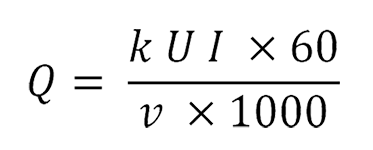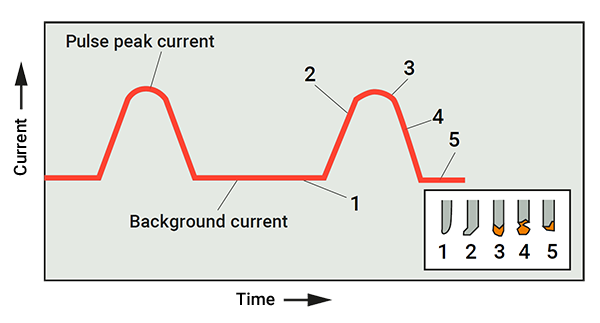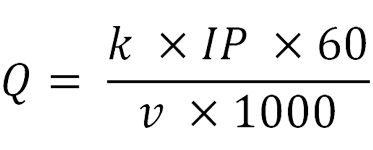Heat input
The heat input from a welding performance describes the delivered energy/welded length of the joint. The level of the heat input affects the mechanical properties and microstructures of the joint. From a user´s perspective the principal interest are how it affects:
- The mechanical properties in the joint
- The resistance to discontinuities and defects in the joint
The type of current used determines how this parameter is to be calculated.
During welding there is a loss of energy in the arc. The thermal efficiency k expresses the part of the heat input that is transferred to the joint during the welding performance. The value of this parameter depends on the welding process being used and the specific welding conditions. Approximate values for different welding processes are according to the table below.
| Thermal efficiency | k [dimensionless] |
| MMA | 0.8 |
| MAG, all types |
0.8 |
| SAW | 1.0 |
| TIG | 0.6 |
The thermal efficiency factors for different welding methods.
Welding performances with DC and AC current
Most welding performances are carried out by DC welding. For DC and AC welding the heat input depends of the applied current, voltage and travel speed according to the following formula.
Q = Heat input [kJ/mm]
U = Voltage [V)
I = Current [A]
V = Welding speed [mm/min]
K = Thermal efficiency [dimensionless]
Pulsed arc welding
Pulsed arc welding is the third option. It means that the current is pulsed. In this case welding can be optimized for a certain type of welding performance. The characteristics of the pulse applied depends on which condition that is to be optimized. Examples in this respect are higher resistance to lack of fusion or a reduced level of spatter.
Typical current appearance during pulsed arc welding.
Or
Where,
IE = Instantaneous energy [J]
L = Length of a weld run [mm]
V = Welding speed [mm/min]
K = Thermal efficiency [dimensionless]
The information in this report is only applicable to SSAB’s products and should not be applied to any other products than original SSAB products.
This report provides general results and recommendations for SSAB steel products. This report is subject to SSAB’s Terms of Use. It shall be the user's responsibility to verify that the information contained herein is correct and is suitable to be used for the particular purpose and application of the user. The report is intended to be used by professional users only who possess adequate expertise, qualification and knowledge for the safe and correct use of the results and recommendations in this report. This report is provided “as is”. The use of the report is at user’s own discretion and risk and that users will be solely responsible for any use of this report. SSAB disclaims any liability for the content or potential errors of this report, including but not limited to warranties and condition of merchantability or fitness for a particular purpose or suitability for individual applications. SSAB shall not be liable for any kind of direct or indirect damages and/or costs related to or arising therefrom, whether special, incidental, consequential or directly or indirectly related to the use of, or the inability to use, the report or the content, information or results included therein.



